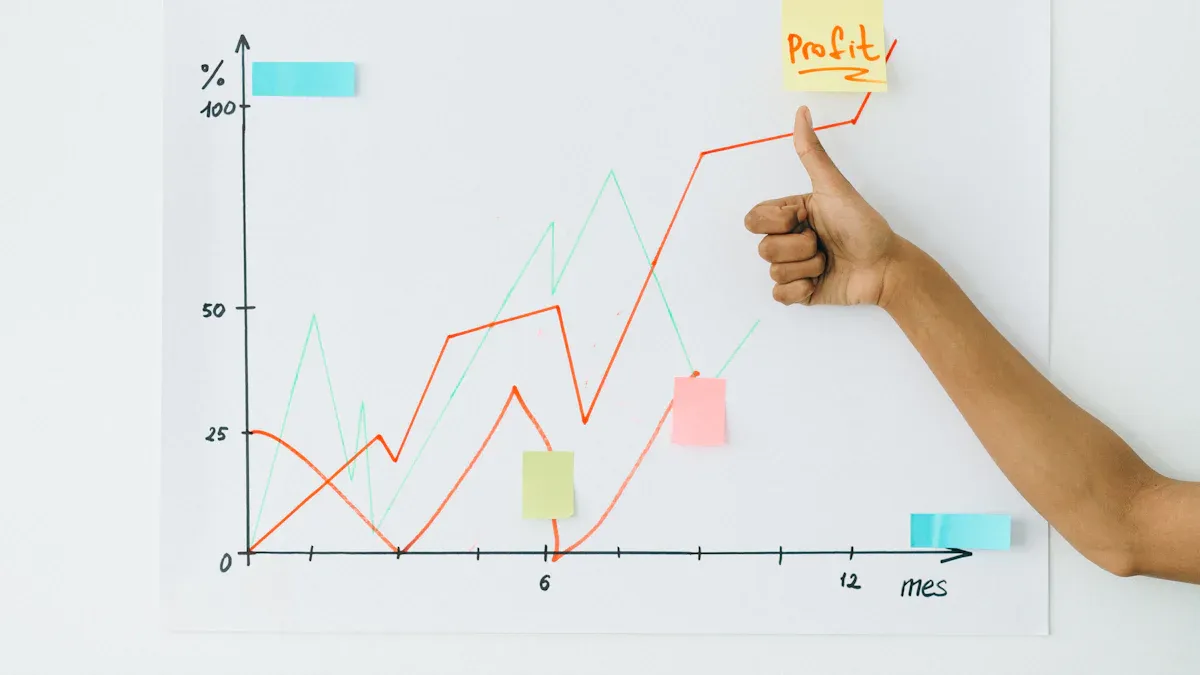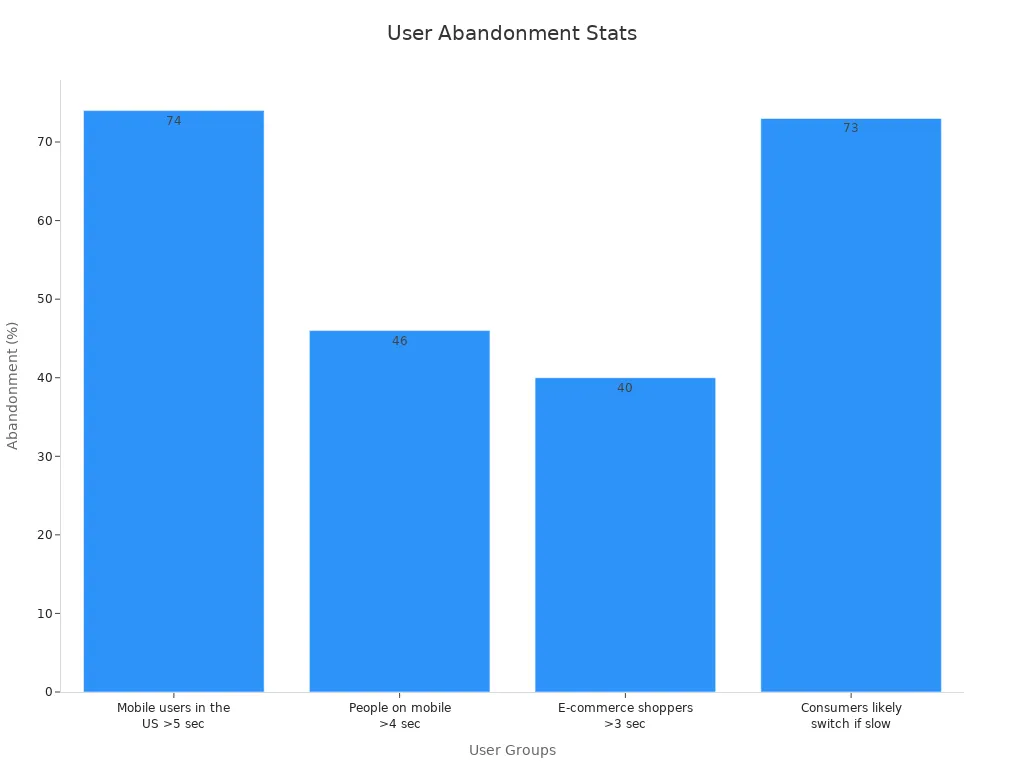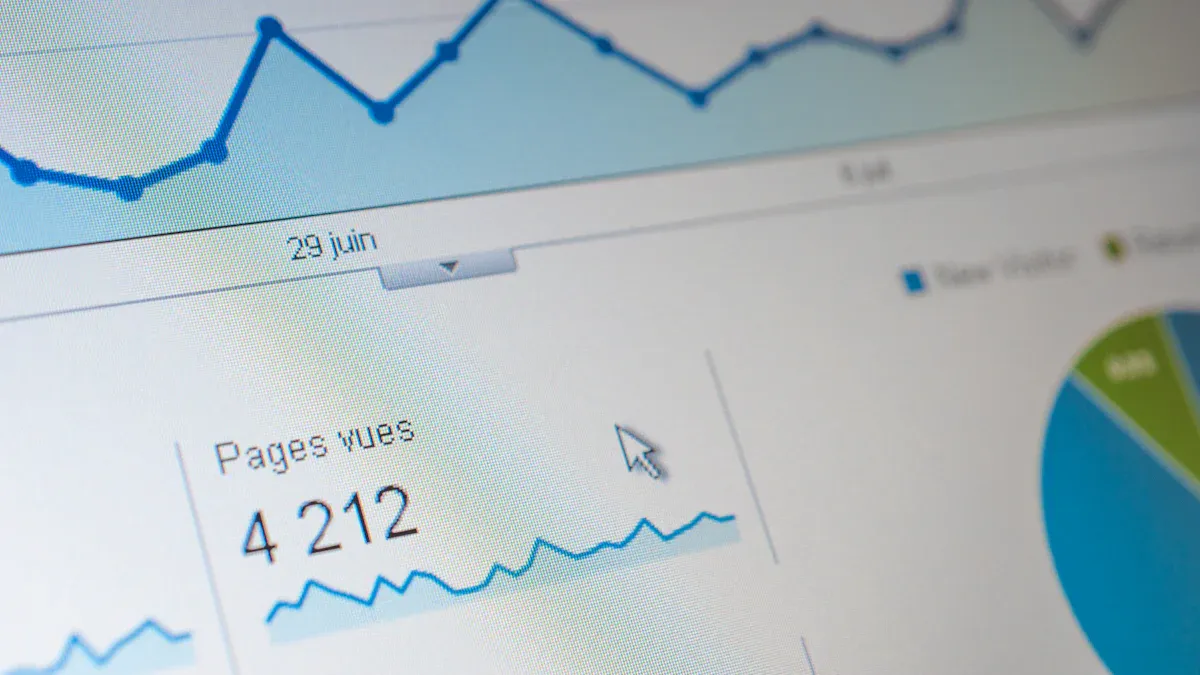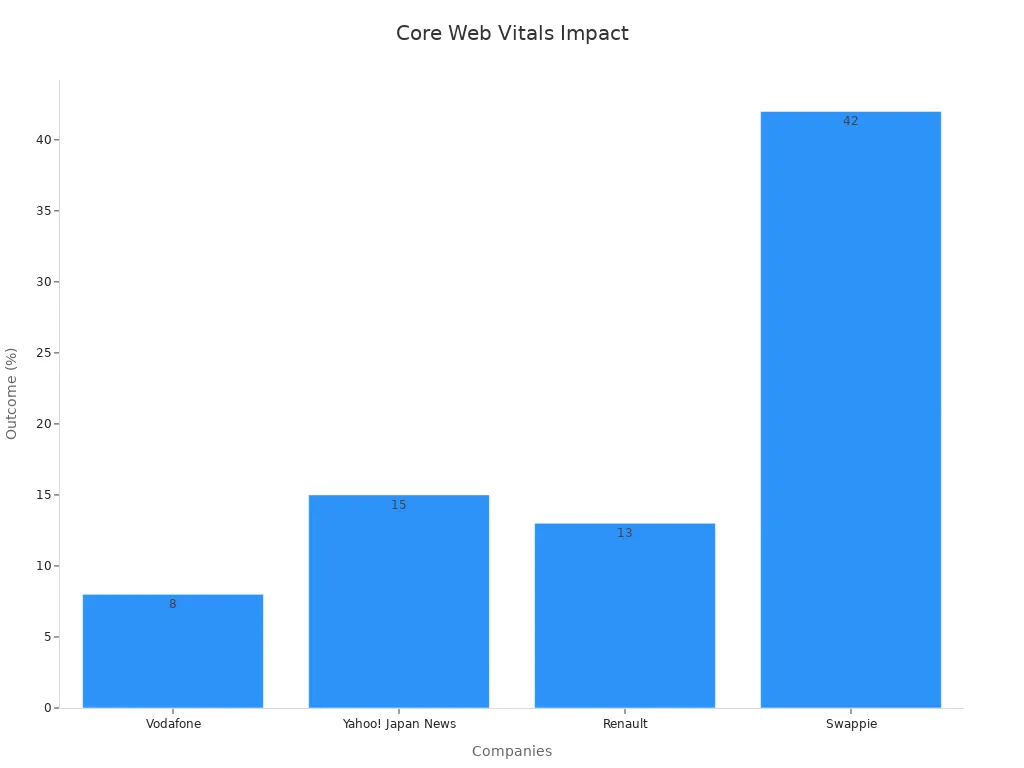How Website Speed Drives More Visits and Increases Sales

Website speed shapes your online success from the first moment a visitor lands on your page. People expect instant results, and even a short delay can drive them away. For example, a Google study found that when page load time jumps from 1 to 3 seconds, bounce probability rises by 32%. The table below shows how small changes in website speed can have a big impact:
Statistic Description | Impact on User Visits |
|---|---|
Increasing page load time from 1 to 3 seconds | Bounce probability increases by 32% |
Mobile users abandoning sites loading >3 seconds | 53% abandonment rate |
Xtreme4x4: Load time reduced from 5 to 2.5 seconds | 20% more user retention, 15% more conversions |
BBC: Each extra second of load time | 10% of users leave the page |
Financial Times: Faster load by a few seconds | 5% increase in engagement |
You face tough competition for attention. Recent reports show that up to 74% of mobile users in the US abandon websites that take longer than five seconds to load. The chart below highlights how impatient users can be:

Key Takeaways
Faster websites keep visitors longer and reduce bounce rates, helping your site get more traffic.
Website speed affects search rankings; faster sites rank higher and attract more users.
Improving load times boosts conversion rates, turning more visitors into customers.
Slow websites cause lost sales and hurt customer satisfaction, costing real money.
Simple fixes like optimizing images and using caching can quickly improve your site speed.
Website Speed and Traffic

Bounce Rates
You want visitors to stay on your site, but slow load times push them away. When your website takes longer than three seconds to load, over half of users leave before seeing your content. Studies show that a delay from one to ten seconds can increase bounce rates by 123%. Even a two-second lag during checkout can cause up to 87% of users to abandon their carts. These numbers highlight how critical speed is for keeping users engaged.
Bounce Rate Increase (%) | |
|---|---|
1 to 3 | 32 |
1 to 5 | 90 |
1 to 6 | 106 |
1 to 10 | 123 |
You can see the impact visually:

When you improve website speed, you reduce bounce rates and keep more visitors on your site. Research from Google and other industry leaders confirms that faster sites see better retention and engagement.
SEO Impact
Search engines want to give users the best experience. Google uses website speed as a ranking factor for both desktop and mobile searches. If your site loads slowly, you risk dropping in search results, which means fewer people find you. Google’s updates in 2010, 2018, and 2021 all increased the importance of speed, especially for mobile users. Today, Google’s Core Web Vitals measure how quickly your site responds and loads for real users.
Metric | Description | Correlation with Search Ranking |
|---|---|---|
Time until first byte is received from server (includes network latency and backend speed) | Strong negative correlation (lower TTFB = higher rank) | |
Document Complete | Time until page is interactive (partial content loaded) | No clear correlation |
Fully Rendered | Time until all content including images and ads are loaded | No clear correlation |
A one-second delay in load time can decrease page views by 11%. For ecommerce, every extra second of load time drops conversion rates by 0.3%. If your site is easy to use and loads quickly, 79% of users say they are more likely to revisit and share it. On the other hand, 62% of users avoid buying from brands after a poor mobile experience.
Tip: Focus on improving your server response time and optimizing images. These steps help boost your search ranking and attract more organic traffic.
First Impressions
You never get a second chance to make a first impression. Most users form an opinion about your website within seconds. If your site loads slowly, visitors may leave before they even see your content. About 53% of mobile users exit if a page takes longer than three seconds to load. This immediate abandonment damages your brand’s credibility and reduces your chances of making a sale.
Statistic / Insight | Description |
|---|---|
Indicates immediate abandonment due to slow load speed, showing first impression impact | |
7% reduction in conversions per 1-second delay | Demonstrates how even small delays negatively affect user actions |
32% increase in bounce rates for pages loading > 3 seconds | Shows user frustration and disengagement linked to slow load times |
Average load time of top 20 US websites is 1.08 seconds | Sets user expectations for fast load speed, influencing first impressions |
Users expect pages to load in under 3 seconds (Google data) | Highlights user impatience and the importance of fast initial impressions |

Website speed shapes how users feel about your business from the very start. Fast-loading sites build trust and encourage users to stay, explore, and buy.
Speed and Sales

Conversion Rates
You want your website to turn visitors into customers. Website speed plays a major role in this process. Faster sites make it easier for users to complete actions, such as signing up or making a purchase. Even a small improvement in load time can boost your conversion rates. For example, a Deloitte and Google study found that a 0.1-second improvement in load time increased conversions by up to 10.1%, depending on the industry. Other brands like Rakuten 24 and OfficeRnD saw conversion rates jump by 33% and 10% after optimizing their site performance.
Source / Case Study | Speed Improvement Context | Conversion Rate Change (%) |
|---|---|---|
Deloitte & Google Study | 0.1 second faster load time | 3.6% to 10.1% increase |
Rakuten 24 | Core Web Vitals optimization | 33.13% increase |
redBus | INP optimization | 7% increase |
OfficeRnD | Web performance optimization | 10% increase |
General Statistic | 1 second faster load time | 17% increase |
OuterBoxDesign (2023) | 1 second delay in load time | 7% decrease in conversions |
You can see a clear pattern: faster websites convert more visitors. Noibu’s research shows that sites loading in about 2.4 seconds have an average conversion rate of 1.9%. When load times reach 4.2 seconds, conversion rates drop below 1%. If your site loads in just 1 second, you can achieve conversion rates 2.5 times higher than those with 5-second load times. YOTTAA’s analysis of over 1,500 eCommerce sites confirms this trend. Faster pages consistently deliver higher conversion rates and more revenue.
Note: Improving website speed not only increases conversions but also reduces user frustration and bounce rates.
Revenue Loss
Slow websites do not just frustrate users—they cost you real money. A one-second delay in page load time can reduce conversion rates by 7%. Customer satisfaction drops by 16% with the same delay. Outdoor retailer Rossignol.com improved its load time by 1.9 seconds and saw a 94% increase in conversion rate. Aberdeen Group research found that a one-second delay leads to 11% fewer page views, 16% lower customer satisfaction, and 7% fewer conversions.
63% of visitors abandon a site if it takes more than four seconds to load.
Third-party apps can account for 44% of total page load time, slowing down your site and hurting sales.
Mobile users with fast-loading pages generate up to 75% more revenue than average, while slow pages can lose over 300% in potential revenue.
Every 1-second delay in load time can mean millions in lost sales for large retailers.
Metric / Impact | Detail / Statistic | Revenue Impact / Consequence |
|---|---|---|
Bounce Rate Increase | 63% of visitors abandon if page load > 4 seconds | Significant loss of potential customers and sales |
Third-Party Apps Contribution to Load | 44% of total page load time | Slower pages lead to higher bounce and lower conversions |
Conversion Rate Drop per 1s Delay | 7% reduction in conversion rate | Millions in lost sales for large retailers |
Conversion Loss from Poor Apps | 0.29% drop per “red-rated” third-party app; cumulative >1% with multiple apps | Substantial revenue drain scaling with traffic volume |
Mobile Traffic Share | Over 80% of web traffic comes from mobile devices | Neglecting mobile optimization leads to lost sales and brand damage |
Bounce Rate at 4s Load Time | 63% abandonment vs. 45% at ≤4 seconds load time | Direct correlation between load speed and customer retention |
You can see that every second counts. Walmart reported a 2% increase in conversion rates for every 1-second improvement in page load time. Amazon found that every 100-millisecond improvement led to a 1% increase in revenue. Even a small delay can cause a 7% drop in sales. Pinterest improved perceived wait time by 40%, which resulted in a 15% increase in SEO traffic and a 10% increase in ad revenue.
Case Studies
Many leading brands have proven the value of website speed through real-world results. These case studies show how even small improvements can drive big gains in sales and conversions.
Company | Year | Industry | Speed Improvement Metric | Sales/Conversion Impact |
|---|---|---|---|---|
Amazon | 2009 | eCommerce | Every 100ms latency increase | 1% loss in sales |
Firefox | 2010 | Internet | Reduced page load time by 2.2 seconds | 15.4% increase in download conversions |
Walmart | 2012 | eCommerce | 100ms faster page load | Up to 1% increase in incremental revenue |
Staples | 2014 | eCommerce | Homepage load time reduced by 1 second | ~10% increase in conversions |
Vodafone | 2021 | Telecommunications | 31% improvement in Largest Contentful Paint (LCP) | 8% more sales, 15% lead to visit rate, 11% cart to visit rate |
Swappie | 2021 | eCommerce | 23% lower average page load time | 42% increase in mobile revenue |
Renault | 2021 | Automotive | 1 second improvement in LCP | 13% increase in conversions, 14ppt decrease in bounce rate |
Mobify | 2016 | eCommerce | Every 100ms faster checkout load speed | 1.55% more conversions on average |
Zitmaxx Wonen | 2017 | eCommerce | Load time under 4 seconds, perfect PageSpeed score | 50.2% increase in mobile conversions |
Tokopedia | 2020 | eCommerce | JavaScript and image optimizations | 35% increase in CTR, 8% increase in conversions |
Walmart saw a 2% increase in conversion rates for every 1-second improvement in page load time.
Amazon reported that every 100-millisecond improvement in load time led to a 1% increase in revenue.
Vodafone increased sales by 8% after optimizing Core Web Vitals.
eBay saw a 0.5% increase in "Add to Cart" clicks for every 0.1-second speed improvement.
Yelp improved its conversion rate by 15% after speeding up First Contentful Paint.
Tip: You can reduce friction in the buying process by making your site faster. Users move through the purchase funnel more easily, leading to higher sales and better customer satisfaction.
Website speed does not just improve user experience—it directly impacts your bottom line. When you invest in speed, you create a smoother path for users to become customers and boost your revenue.
Speed Metrics
Core Web Vitals
You can measure your website’s performance using Core Web Vitals. These are three key metrics that Google uses to judge user experience:
Largest Contentful Paint (LCP): Measures how quickly the main content loads. Aim for 2.5 seconds or less.
Interaction to Next Paint (INP): Replaces First Input Delay (FID) and tracks how fast your site responds when users interact.
Cumulative Layout Shift (CLS): Checks if elements move around while the page loads. Lower scores mean more stable pages.
These metrics focus on what users actually see and feel. Research shows that improving Core Web Vitals leads to faster load times, smoother interactions, and fewer layout shifts. Moz and Google both highlight that hitting these targets boosts engagement, conversions, and search rankings. For example, T-Mobile improved Core Web Vitals and saw a 60% increase in visit-to-order rate.
Meeting Google’s recommended thresholds for Core Web Vitals ensures most users have a positive experience.
Performance Tools
You have many tools to measure and improve website speed. Each tool offers unique features to help you find and fix issues:
Tool Name | Key Features & Strengths | Best Use Case |
|---|---|---|
Measures Core Web Vitals, gives SEO tips, compares mobile and desktop speeds | Free, actionable insights for all sites | |
GTmetrix | Detailed breakdowns, file size analysis, ongoing monitoring | In-depth analysis and regular checks |
Pingdom | Focuses on content type impact, 30-day free trial | Quick tests and content-specific optimization |
WebPageTest | Core Web Vitals reports, multiple test locations | Testing for different regions and devices |
SEO Site Checkup | Speed, SEO, and mobile usability insights | All-in-one diagnostics |
Uptrends | Customizable tests, advanced monitoring | Advanced control and monitoring |
Dotcom-Monitor | Server response, DNS, and speed testing | Integration with other monitoring tools |
Geekflare | Core Vitals check, HTTP/3, security status | Technical assessment for new sites |
You can also use browser tools like Google Chrome DevTools for real-time testing and Lighthouse audits. Regular testing helps you spot slowdowns before they affect your users.
Key Indicators
Tracking the right metrics helps you understand how website speed affects your business. Focus on these indicators:
Page Load Time: Faster pages keep users engaged and reduce bounce rates.
Core Web Vitals Scores: Good LCP, INP, and CLS scores lead to higher conversions and better SEO.
Bounce Rate: Lower bounce rates mean more visitors stay and interact.
Session Duration: Longer sessions show users find your site useful.
Conversion Rate: Faster sites convert more visitors into customers.
Research shows that even a 0.1-second improvement in load speed can boost conversions by over 8%. Vodafone improved LCP and saw an 8% increase in sales. Swappie optimized Core Web Vitals and increased mobile revenue by 42%.
Company | Core Web Vital Metric Improved | Business Outcome |
|---|---|---|
Vodafone | Largest Contentful Paint (LCP) | 8% increase in sales |
Yahoo! Japan News | Cumulative Layout Shift (CLS) | 15% increase in page views |
Renault | 1 second improvement in LCP | 13% increase in conversions |
Swappie | Core Web Vitals overall | 42% increase in mobile revenue |

When you monitor these metrics, you can spot problems early and make changes that drive more visits and sales. Website speed is not just a technical detail—it is a key driver of business growth.
Improve Website Speed
Quick Fixes
You can boost website speed right away with a few simple changes.
Use asynchronous loading for scripts by adding the
asyncattribute. This prevents scripts from blocking your page as it loads.Optimize images by converting them to modern formats like WebP or AVIF. Smaller images load faster and keep your site sharp.
Implement lazy loading for images below the fold. This means your site loads only what users see first, improving perceived speed.
Minify your code by removing unnecessary spaces and comments in JavaScript and CSS files.
Reduce the number of HTTP requests by combining files and limiting the number of images or scripts.
Enable HTTP/2 or HTTP/3 protocols on your server. These protocols allow multiple files to load at once, cutting down wait times.
Choose a reliable hosting platform and set up server-side caching to lower server response times.
Quick fixes like these can cut load times by up to 50% and lead to immediate gains in user satisfaction and conversion rates.
Technical Steps
For long-term results, you need to take deeper technical actions:
Compress and resize images using tools like TinyPNG, and always pick the best format for each image.
Use a Content Delivery Network (CDN) to deliver your content from servers closer to your users.
Minify CSS, JavaScript, and HTML files to reduce download times.
Enable browser caching so repeat visitors load your site even faster.
Upgrade your hosting or database to handle more traffic and speed up server response.
Design responsive layouts for mobile devices.
Continuously monitor your site with tools like Google PageSpeed Insights and GTmetrix.
These steps help you maintain fast load times as your site grows.
Ongoing Optimization
Website speed is not a one-time fix. You need to monitor and improve it regularly.
Launch updates quickly and test changes based on real user data.
Track key metrics like bounce rate, conversion rate, and Core Web Vitals.
Use agile methods to make small, steady improvements.
Involve your team in finding and fixing speed issues.
Company | Speed Change | Business Impact |
|---|---|---|
Bing | 2s slower | 4.3% drop in revenue per user |
Shopzilla | 5s faster | 7-12% more conversions, double sessions |
Mozilla | 2.2s faster | 15.4% more downloads |
Regular optimization keeps your site competitive, improves search rankings, and drives more sales.
You can see a clear connection between website speed, more visits, and higher sales. Fast-loading sites keep users engaged and ready to buy. The table below highlights how even small improvements drive big results:
Metric / Finding | Impact on Sales / User Behavior | Source / Study |
|---|---|---|
2% higher conversion rates | Walmart Study | |
100ms slower load time | 1% sales decrease | Amazon 2008 Study |
8.4% more conversions, 9.2% higher order value | Deloitte 2020 |
You should act now to optimize your website speed and secure long-term business growth.
FAQ
How fast should your website load?
You should aim for your website to load in under 3 seconds. Most users expect quick results. If your site loads faster, you keep more visitors and improve your chances of making a sale.
What tools can you use to test website speed?
You can use free tools like Google PageSpeed Insights, GTmetrix, or Pingdom. These tools show you what slows down your site and suggest ways to fix it.
Tip: Test your site on both desktop and mobile for the best results.
Does website speed affect mobile users more?
Yes, mobile users often have slower connections. If your site loads slowly on mobile, you lose visitors quickly. Fast mobile sites keep users engaged and help you rank higher in search results.
What are the easiest ways to speed up your website?
Compress images before uploading.
Minify CSS and JavaScript files.
Use browser caching.
Choose a reliable hosting provider.
These steps give you quick wins and improve user experience.
